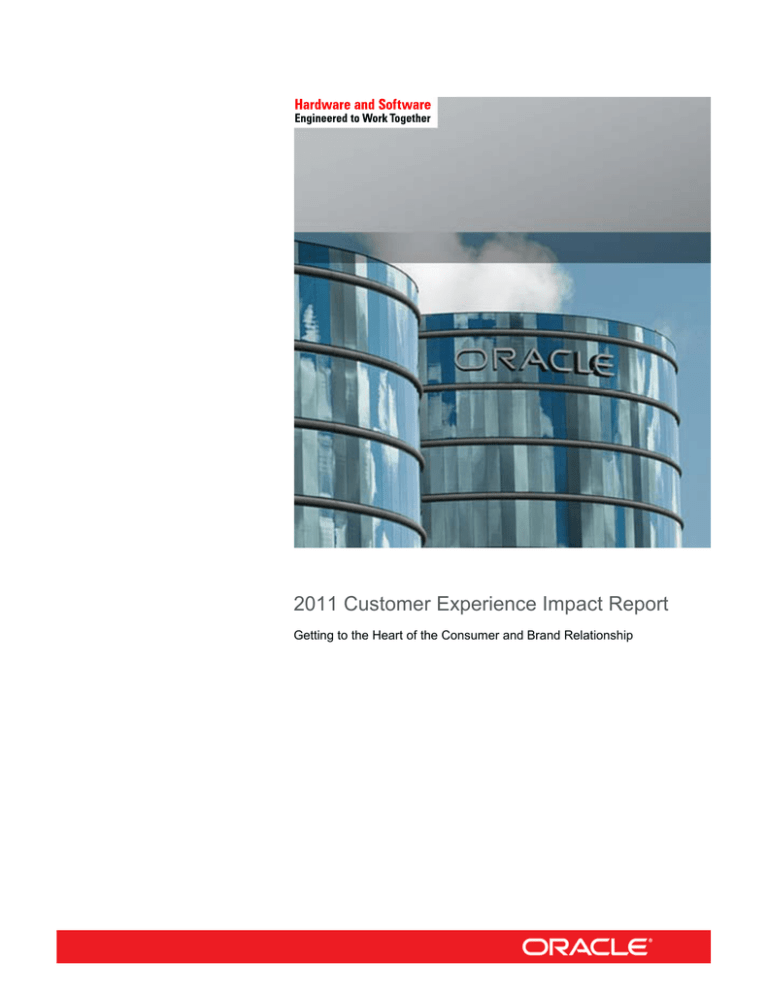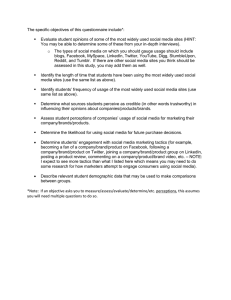
2011 Customer Experience Impact Report
Getting to the Heart of the Consumer and Brand Relationship
Today, consumers call the shots. With globalization
and the internet providing nearly unlimited
choices, power has shifted from corporations to
consumers. This shift makes it nearly impossible for
companies to sustain differentiation based solely
on price or product. The only option that remains is
the customer experience.
Consumers want personal and engaging experiences that develop into relationships.
Much like the trials and rewards of personal relationships, when done right, brand
relationships can grow into lifetime commitments. When done wrong, they can lead to
painful breakups.
The 2011 Customer Experience Impact (CEI) Report explores the relationship between
consumers and brands. Based on a survey* commissioned by RightNow (acquired by
Oracle in March 2012) and conducted by Harris Interactive, the report reveals facts
about what consumers are looking for from a brand, how quickly they will dump a
favorite brand, and their tendency to seek retribution after a breakup. It also showed
the following:
•
86 percent of consumers will pay more for a better customer experience.
•
89 percent of consumers began doing business with a competitor following a poor
customer experience.
•
79 percent of consumers who shared complaints about poor customer experience
online had their complaints ignored.
•
50 percent of consumers give a brand only one week to respond to a question before
they stop doing business with them.
2
Courting the Customer
Why Consumers Commit to a Brand
When it comes to consumer expectations for great experiences, there are several tactics
a brand can use to woo a customer. What makes a memorable experience that causes
consumers to stick with a brand? According to the CEI survey, consumers want
QUICK FACT
86 percent of consumers will pay more for
a better customer experience.
•
Friendly employees or customer service representatives (73 percent)
•
The ability to easily find the information or help they need (55 percent)
•
Personalized experiences (36 percent)
•
Brands with a good reputation (33 percent)
Based on the survey responses, hiring and empowering the right staff is the most critical
element to successfully courting consumers. Next, brands must ensure easy access to
information and support. Brands also need to create personalized experiences; this
includes knowing what customers have bought in the past and service issues they’ve
raised, as well as sending appropriate, timely, and useful updates.
Loyalty Pays
Brands Benefit When Consumers Are Happy
Positive engagements create long-standing, loyal relationships, and this is so important
to consumers that they are willing to pay for it. In fact, according to the CEI survey, 86
percent of consumers will pay more for a better customer experience.
Not just single organizations, but entire industries, stand to benefit and gain significant
revenue by improving the customer experience. For example, by ensuring great
customer experiences, the United States airline industry could have made an additional
US$8.94 billion in 2010. 1 Wireless carriers could earn an additional US$14.65 billion
each year through better customer experiences. 2
1
2
Calculated based on the following data:
•
Air Transport Association’s average round-trip amount paid by domestic passengers, including the fare and any
reservation change fees or baggage fees in 2010, equals US$337.97.
•
Bureau of Transportation Statistics’ number of 2010 passengers for U.S. flights on domestic airlines is 629.5 million.
•
The 5 percent extra that consumers would pay for a better experience (US$16.90) on an average fare multiplied by 84
percent of the number of passengers on domestic airlines (528,780,000) equals US$8,936,382,000.
Calculated based on the following data:
•
The CTIA estimates that at the end of 2010, the U.S. had some 302.9 million mobile subscribers.
•
JD Power estimates the average annual wireless phone bill to be US$1,152—5 percent of this is US$57.60.
•
If 84 percent of all American subscribers (254,436,000) each paid an additional 5 percent (US$57.60) per year on an
average bill, this amounts to US$14,655,513,600.
3
Breaking Up Isn’t Hard to Do
When Expectations Are Not Met, Brands Get Dumped
With only 1 percent of consumers feeling that their expectations for a good customer
experience are always met, it is easy to see why the relationship between brands and
consumers often flames out. Poor experiences are due to unmet expectations, leading
consumers to take their business elsewhere.
QUICK FACT
•
89 percent of consumers began doing business with a competitor following a poor
customer experience.
•
50 percent of consumers give a brand only one week to respond to a question before
they stop doing business with them.
89 percent of consumers began doing
business with a competitor following a poor
customer experience.
Nothing Worse than a Consumer Scorned
They Tell Their Facebook Friends and Twitter Followers
After a poor customer experience, more than a quarter of consumers (26 percent)
posted a negative comment on a social networking site like Facebook or Twitter for
hundreds—even thousands—of their friends and followers to see. According to the
CEI survey:
•
79 percent of consumers who shared complaints about poor customer experience
online had their complaints ignored.
•
Of the 21 percent who did get responses to complaints, more than half had positive
reactions to the same company about which they were previously complaining.
A simple response can make a tremendous difference. By acknowledging complaints,
organizations stand to win back frustrated customers. In the instances when an
organization responded to a customer’s negative comment, here’s what happened:
•
46 percent of consumers were pleased.
•
22 percent posted a positive comment about the organization.
4
Keeping the Relationship Alive
How to Meet Consumer Expectations for Great Customer Experiences
For consumer organizations today, good customer experience is a competitive
imperative. Understanding what customers want is the first step in creating exceptional
experiences. When asked specifically how companies can better engage with
consumers to spend more, respondents said the following:
•
Improve the overall customer experience (54 percent).
•
Make it easy to ask questions and access information before making a purchase
(52 percent).
•
Improve search functionality and overall Website usability (36 percent).
QUICK FACT
A Roadmap for Success
50 percent of consumers give a brand only
one week to respond to a question before
they stop doing business with them.
The CEI survey revealed several areas where brands have fallen short. Other consumer
organizations can learn from these blunders:
•
Pick up the phone. 58 percent of consumers noted that their expectations were not
met because a company was unavailable by phone and e-mail.
•
Shake a leg. 56 percent said companies are slow to resolve issues.
•
Get a clue. 57 percent said companies are clueless; it sometimes feels like the
consumer knows more about the company than the customer service agent.
•
Be friendly. 51 percent said companies are impersonal; sometimes they can’t even
get the customer’s name right.
•
Know your customer’s interaction history. 34 percent said companies are
forgetful; they don’t even remember a customer who has recently talked to a customer
service agent.
•
Get social. 16 percent said companies are antisocial; they are nowhere to be found
on social networking sites.
As in years past, the CEI Report continues to indicate that exceptional customer
experiences are essential to any consumer organization that needs to grow and sustain
competitive differentiation in today’s market. If brands deliver the experiences
consumers want, consumers will reciprocate with long-lasting, fruitful relationships.
5
Oracle Corporation
Copyright © 2012, Oracle and/or its affiliates. All rights reserved. This document is provided for information purposes only and the contents hereof are
World Headquarters
subject to change without notice. This document is not warranted to be error-free, nor subject to any other warranties or conditions, whether expressed
500 Oracle Parkway
orally or implied in law, including implied warranties and conditions of merchantability or fitness for a particular purpose. We specifically disclaim any
Redwood Shores, CA 94065
liability with respect to this document and no contractual obligations are formed either directly or indirectly by this document. This document may not be
U.S.A.
reproduced or transmitted in any form or by any means, electronic or mechanical, for any purpose, without our prior written permission.
Worldwide Inquiries:
Phone: +1.650.506.7000
Fax: +1.650.506.7200
oracle.com
Oracle and Java are registered trademarks of Oracle and/or its affiliates. Other names may be trademarks of their respective owners.
AMD, Opteron, the AMD logo, and the AMD Opteron logo are trademarks or registered trademarks of Advanced Micro Devices. Intel and Intel Xeon are
trademarks or registered trademarks of Intel Corporation. All SPARC trademarks are used under license and are trademarks or registered trademarks
of SPARC International, Inc. UNIX is a registered trademark licensed through X/Open Company, Ltd. 0312


